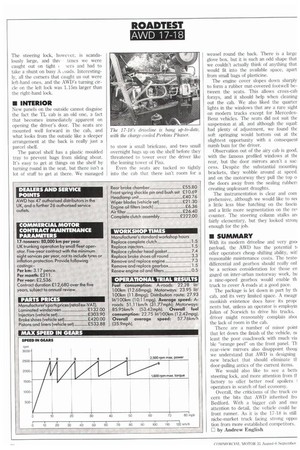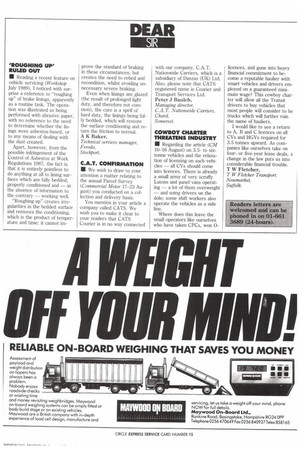ROADTEST
Page 34

Page 35

If you've noticed an error in this article please click here to report it so we can fix it.
AWD 17-18
The steering lock, however, is scandalously large, and thr( times we were caught out on tight ( •iers and had to take a shunt on busy A wads. Interestingly, all the corners that caught us out were left-hand ones, and the AWD's turning circle on the left lock was 1.15m larger than the right-hand lock.
New panels on the outside cannot disguise the fact the TL cab is an old one, a fact that becomes immediately apparent on opening the driver's door. The seats are mounted well forward in the cab, and what looks from the outside like a sleeper arrangement at the back is really just a parcel shelf.
The parcel shelf has a plastic moulded tray to prevent bags from sliding about. It's easy to get at things on the shelf by turning round in the seat, but there isn't a lot of stuff to get at there. We managed
to stow a small briefcase, and two small overnight bags up on the shelf before they threatened to tower over the driver like the leaning tower of Pisa.
Even the seats are tucked so tightly into the cab that there isn't room for a weasel round the back. There is a large glove box, but it is such an odd shape that we couldn't actually think of anything that would fit into the available space, apart from small bags of plasticine.
The engine cover slopes down sharply to form a rubber mat-covered footwell between the seats. This allows cross-cab forays, and it should help when cleaning out the cab. We also liked the quarter lights in the windows that are a rare sight on modern trucks except for MercedesBenz vehicles. The seats did not suit the suspension at all, and although the squat had plenty of adjustment, we found the soft springing would bottom out at the slightest opportunity with a consequent numb bum for the driver.
Observation out of the airy cab is good, with the famous profiled windows at thE rear, but the door mirrors aren't a suc. cess. Despite the substantial mountir4 brackets, they wobble around at speed. and on the motorway they pull the top o the doors away from the sealing nibber: creating unpleasant draughts.
The instrumentation is clear and corn prehensive, although we would like to se( a little less blue hatching on the fascia and a little more segmentation on the re, counter. The steering column stalks an fairly elementary, but they looked stronj enough for the job.
• SUMMARY
With its modern driveline and very goo payload, the AWD has the potential ti offer operators cheap shifting ability, wit) reasonable maintenance costs. The teste, differential and gearbox should really onl be a serious consideration for those en gaged on inter-urban motorway work, by a nine-speed gearbox would enable th truck to cover A-roads at a good pace.
The package is let down in part by th cab, and its very limited space. A meagr monkish existence does have its prop( nents hut, unless an operator is employin Julian of Norwich to drive his trucks, driver might reasonably complain abot the lack of room in the cab.
There are a number of minor point that let down the finish of the vehicle. n( least the poor coachwork with much vis ble "orange peel" on the front panel. Th rear-view mirrors also disappoint thoup we understand that AWD is designing new bracket that should eliminate th door-pulling antics of the current items.
We would also like to see a bett( steering lock, and more attention from ti factory to offer better roof spoilers operators in search of fuel economy.
Overall, the criticisms of the truck co cern the bits that AWD inherited fro Bedford. With a bigger cab and moi attention to detail, the vehicle could be front runner. As it is the 17-18 is still niche-market truck facing strong ()ppm tion from more established competitors. 0 by Andrew English 'ROUGHING UP' RULED OUT
• Reading a recent feature on vehicle servicing (Workshop July 1989), I noticed with surprise a• reference to "roughing up" of brake linings, apparently as a routine task. The operation was illustrated as being performed with abrasive paper, with no reference to the need to determine whether the linings were asbestos-based, or to any means of dealing with the dust created.
Apart, however, from the possible infringement of the Control of Asbestos at Work Regulations 1987, the fact is that it is entirely pointless to do anything at all to lining surfaces which are fully bedded, properly conditioned and — in the absence of information to the contrary — working well.
"Roughing up" creates irregularities in the bedded surface and removes the conditioning, which is the product of temperature and time; it cannot im
prove the standard of braking in these circumstances, but creates the need to rebed and recondition, whilst avoiding unnecessary severe braking.
Even when linings are glazed (the result of prolonged light duty, and therefore not common), the cure is a spell of hard duty, the linings being fully bedded, which will restore the surface conditioning and return the friction to normal. A K Baker,
Technical services manager, Ferodo, Stockport.
C.A.T. CONFIRMATION 11 We wish to draw to your attention a matter relating to the annual Parcel Survey (Commercial Motor 17-23 August) you conducted on a collection and delivery basis.
You mention in your article a company called CATS. We wish you to make it clear to your readers that CATS Courier is in no way connected with our company, C.A.T. Nationwide Carriers, which is a subsidiary of Danzas (UK) Ltd. Also, please note that CATS registered name is Courier and Transport Services Ltd.
Peter J Baulch,
Managing director, C.A.T. Nationwide Carriers, Chard, Somerset.
COWBOY CHARTER THREATENS INDUSTRY • Regarding the article (CM 10-16 August) on 3.5to sixtonne vehicles and the relaxation of licensing on such vehicles — all CVs should come into licences. There is already a small army of very scruffy Lutons and panel vans operating — a lot of them overweight — and using drivers on the dole; some shift workers also operate the vehicles as a side line.
Where does this leave the small operators like ourselves who have taken CPCs, won 0 licences, and gone into heavy financial commitment to become a reputable haulier with smart vehicles and drivers employed on a guaranteed minimum wage? This cowboy charter will allow all the Transit drivers to buy vehicles that most people will consider to be trucks which will further ruin the name of hauliers.
I would like to see a return to A, 13 and C licences on all CVs and HGVs required for 3.5 tonnes upward. As companies like ourselves take on fouror five-year lease deals, a change in the law puts us into considerable financial trouble. T W Fletcher,
T W Fletcher Transport, Newmarket, Suffolk.
































































































































